“Scent of Mystery” Playdate History |
Read more at in70mm.com The 70mm Newsletter |
| Written by: David Coles, Sydney, Australia | Date: 03.02.2015 |
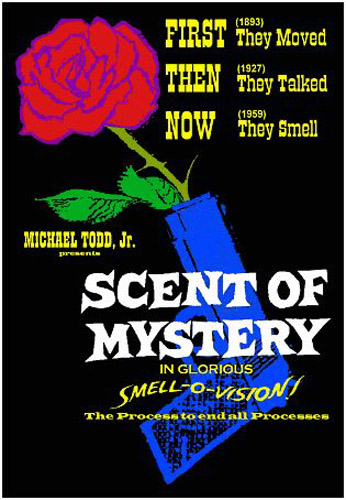 Photographed entirely in Spain from March 30 to July 4, 1959 using a
Mitchell BNC 65mm camera,
"Scent of Mystery" would be released in a
variety of formats (but never a 35mm print down version!) Here are the
significant exhibition dates: Photographed entirely in Spain from March 30 to July 4, 1959 using a
Mitchell BNC 65mm camera,
"Scent of Mystery" would be released in a
variety of formats (but never a 35mm print down version!) Here are the
significant exhibition dates:“SCENT OF MYSTERY” in the ‘New Todd Process’ (i.e. in 70mm), Belock (aka Todd-Belock) 8 channel Stereophonic sound, Toddcolor and Smell-O-Vision. [World Premiere 8.40pm Wednesday January 6, 1960 at Todd’s CINESTAGE Chicago] CHICAGO Todd’s CINESTAGE: January 6, 1960 to May 7, 1960 (18 weeks) LOS ANGELES RITZ: January 25, 1960 to c May 30, 1960 (14 weeks) NEW YORK WARNER: February 18, 1960 to May 22, 1960 (14 weeks) “SCENT OF MYSTERY” in ‘70mm Todd Process’, 6 channel Hi-Fi Stereophonic sound, Toddcolor and WITHOUT Smell-O-Vision. MINNEAPOLIS St. Louis PARK: June 3, 1960 to July 7, 1960 (5 weeks) [preset season] [Footnote: "The Tale of Old Whiff" (‘the 1st 70mm cartoon’ – now believed lost) screened at all “Scent of Mystery” showings. (It also contained smells).] “HOLIDAY IN SPAIN” (edited version of “Scent of Mystery”) presented in (3-strip) Cinemiracle, 7 track Stereo sound and Technicolor. [World Premiere 8.30pm Friday December 22, 1961 at EGLINTON Toronto, Ontario, Canada] TORONTO EGLINTON: December 22, 1961 to May 1, 1962 (19 weeks) SEATTLE PARAMOUNT: May 11, 1962 to May 27, 1962 (3 weeks) |
More in 70mm reading: Be part of Smell-O-Vision history! A campaign to re-start Mike Todd Jr's. Smell-O-Vision for future screenings of "Holiday In Spain" Mike Todd Jr.'s "Scent of Mystery" in Smell-O-Vision Movies with artificial smells in cinemas: "Behind the Great Wall" and "Scent of Mystery" Who is David Coles? Magnified Grandeur Cinerama Festival Diary 2012 "The Tale of Old Whiff" Oliver Michael Todd in Conversation with Thomas Hauerslev "Holiday In Spain" released on Blu-Ray In The Picture - Tom Down Under John H Mitchell's Twin Presentations Internet link: |
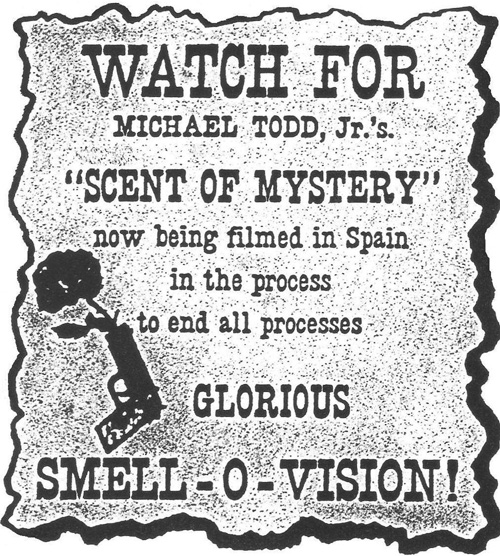 “HOLIDAY IN SPAIN” (using Cinemiracle prints uncredited) presented in
(3-strip) Cinerama, 7 track Stereo sound and Technicolor. “HOLIDAY IN SPAIN” (using Cinemiracle prints uncredited) presented in
(3-strip) Cinerama, 7 track Stereo sound and Technicolor.BOSTON BOSTON: May 7, 1962 to August 5, 1962 (13 weeks) [1st Cinerama showing] MONTREAL IMPERIAL: May 24, 1962 to August 6, 1962 (11 weeks) DETROIT MUSIC HALL: May 25, 1962 to August 5, 1962 (10 weeks) SAN FRANCISCO ORPHEUM: May 29, 1962 to August 5, 1962 (10 weeks) TOLEDO PARAMOUNT: July 20, 1962 to October 2, 1962 (11 weeks) MONTCLAIR CLAIRIDGE September 11, 1962 to November 20, 1962 (10 weeks) ALBANY HELLMAN: December 21, 1962 to January 6, 1963 (3 weeks) VANCOUVER STRAND: February 19, 1964 to March 8, 1964 (3 weeks) |
|
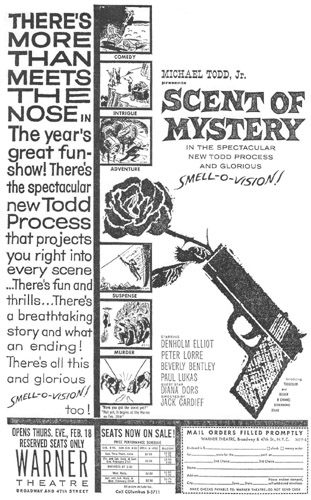 “HOLIDAY IN SPAIN” presented in 70mm Cinerama, 6-track Stereo &
Eastmancolor “HOLIDAY IN SPAIN” presented in 70mm Cinerama, 6-track Stereo &
EastmancolorDENVER INTERNATIONAL 70: c September 23, 1965 to October 19, 1965 (4 weeks) LONDON Coliseum: February 27, 1966 to April 6, 1966 (5 weeks) MANCHESTER ROYAL: March 3, 1966 to March 24, 1966 (3 weeks) BEIRUT (Lebanon) BYBLOS: May 16, 1966 to May 30, 1966 (2 weeks) (then a RETURN SEASON!) August 1, 1966 to August 29, 1966 (4 weeks) CAPETOWN (South Africa) CINERAMA: August 6, 1967 to August 28, 1967 (4 weeks) BUENOS AIRES (Argentina) GAUMONT: late 1967 to early 1968 MENDOZA (Argentina) CITY: February 26, 1968 to April 21, 1968 (8 weeks) BOGOTA (Colombia) SCALA: March 21, 1968 to April 30, 1968 (6 weeks) “HOLIDAY IN SPAIN” presented in (flat) 70mm, 6-track Stereo and Eastmancolor BOGOTA CINE TISQUESUSA: May 31, 1968 to ? (move-over season from the SCALA) [NOTE: This list is not definitive. “HOLIDAY IN SPAIN” almost certainly ran in 70mm Cinerama at Cinerama theatres in Madrid and Barcelona, and in flat 70mm at other cinemas in Spain and South American Spanish speaking countries.] |
|
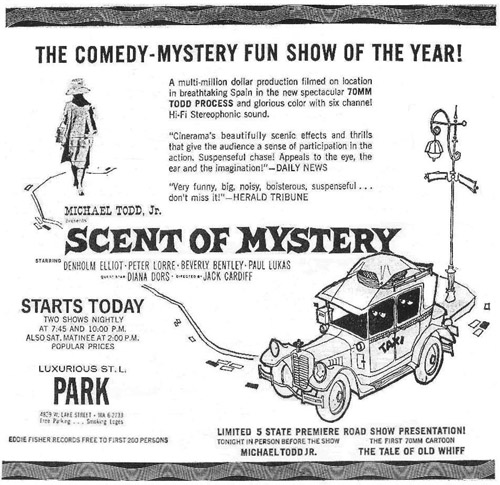 “HOLIDAY IN SPAIN” ‘Rediscovered’ faded 70mm prints shown in
Cinerama. “HOLIDAY IN SPAIN” ‘Rediscovered’ faded 70mm prints shown in
Cinerama.BRADFORD PICTUREVILLE: March 12, 2005 Introduced by director Jack Cardiff LOS ANGELES CINERAMA DOME: Tuesday September 8, 2009 (w “The Golden Head”) Karlsruhe, Schauburg Cinerama: Saturday, October 2, 2010 (w “The Golden Head”) “HOLIDAY IN SPAIN” Reconstructed 2K Digital Version LOS ANGELES CINERAMA DOME: 11pm September 29, 2012 Digital Premiere CINE/TEATRO ALBENIZ Malaga Film Festival (Spain): March 26, 2014 "Holiday In Spain" Bluray released November 11, 2014 by Rewind Productions |
|
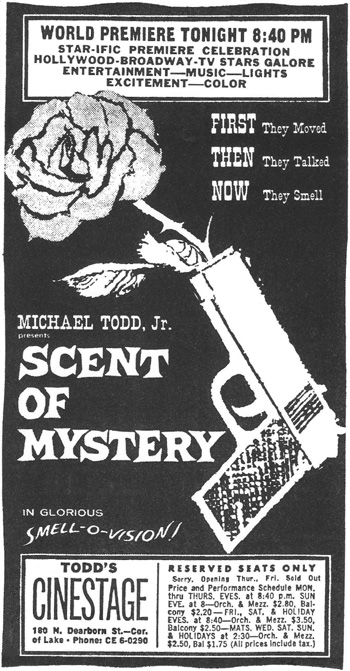 Controlled by the Michael Todd Company
at the time, the Chicago CINESTAGE was used for testing of the
‘Scentovision/Smell-O-Vision’ technique before the World Premiere there
of “SCENT OF MYSTERY” at 8.40pm Wednesday January 6, 1960. A few years
later the cinema would be converted to screen 70mm Cinerama. Controlled by the Michael Todd Company
at the time, the Chicago CINESTAGE was used for testing of the
‘Scentovision/Smell-O-Vision’ technique before the World Premiere there
of “SCENT OF MYSTERY” at 8.40pm Wednesday January 6, 1960. A few years
later the cinema would be converted to screen 70mm Cinerama.When Mike Todd was killed in a plane crash March 22, 1958 revenue was still streaming in from the worldwide boxoffice success of “AROUND THE WORLD IN 80 DAYS” (1956). His Estate was divided 50/50 between his widow Elizabeth Taylor and his son Mike Todd, Jnr. Given the reins of the Michael Todd Production Company by his stepmother, Mike Jnr moved swiftly to shut down preparations for a film version of “DON QUIXOTE” after nearly $200,000 had been spent by Mike Senior. In April he announced that an entirely new film would be produced, based on an idea his father had spoken of 15 years before (and which had obviously inspired Mike Jnr as something with which he could make his mark). By October 1958 Mike Jnr was hopeful that David Niven would star in (and possibly direct) “SCENT OF DANGER” written by William Roos. United Artists, distributors of “80 DAYS” were reportedly keen to finance and release. To follow the boxoffice success of “80 DAYS” with another Todd-Niven vehicle was good business sense – but unfortunately the actor baulked at doing the part. Denholm Elliott ended up playing the hero role, which was so obviously written with David Niven in mind. In July 1959, with principal photography completed on the $2 million production, the plan was to open at the Chicago CINESTAGE (then operated by the MT Corp) in October, with 10-15 other cities to follow with ‘roadshow’ runs. In August, Mike Jnr was anticipating that 25-40 US and 40 overseas houses would install the ‘smellie’ system – with an estimated cost of $20 per seat. “SCENT OF MYSTERY” eventually played 3 theatres in ‘the New Todd Process’, Toddcolor, Todd-Belock 8 channel Stereophonic sound and Smell-O-Vision. Advertising referred to the photographic system as the ‘NEW TODD PROCESS’ and as the new ‘70MM TODD PROCESS’, but nowhere in original material is there any specific reference to ‘TODD-70’ which has come to be accepted by aficionados to distinguish the system from TODD-AO, Super Panavision, MCS-70, etc. Perhaps, as some wag has suggested, it should be more appropriately known as ‘TODD-BO’! (body odour) |
|
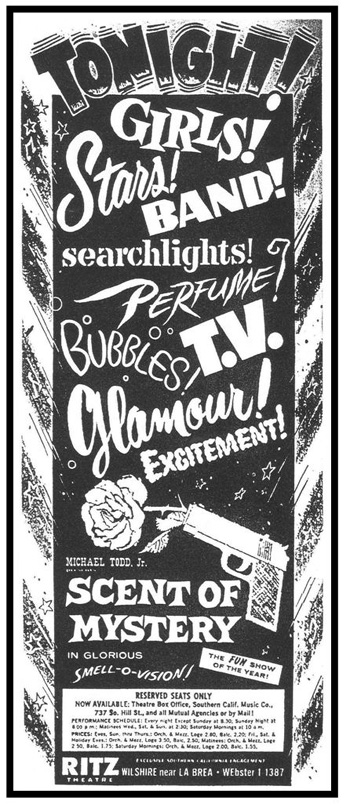 All of the Todd-style razzle dazzle used so successfully on “80 DAYS”
could not help with this one. Normally a live theatre, the Los Angeles
RITZ was the second venue to run “SCENT OF MYSTERY”, opening January 25,
1960 - just a few weeks after Chicago. All of the Todd-style razzle dazzle used so successfully on “80 DAYS”
could not help with this one. Normally a live theatre, the Los Angeles
RITZ was the second venue to run “SCENT OF MYSTERY”, opening January 25,
1960 - just a few weeks after Chicago.In its original “SCENT OF MYSTERY” incarnation a new sound concept was featured, which unfortunately was never used again. Todd-Belock 8-channel Stereophonic sound was essentially normal 6-track magnetic 70mm sound, but with Perspecta-like encoding on the 6th surround channel. This automatically directed that track to left, right and rear auditorium speakers, as appropriate, during the showing. This technique had been applied to the special anamorphic ‘Cinestage’ 4-track magnetic prints of “80 DAYS”. As “MAD WORLD”, the first single-lens Cinerama film, was being readied for release in 1963, there was mention that this ‘Perspecta’ feature might be included in the release prints (along with the special curved screen correction squeeze), but this seemingly very sound idea was never employed there, nor on any other film releases, as far as I am aware. Following the three ‘smellie’ engagements, and probably just one showing without odours, bookings for “SCENT OF MYSTERY” dried up for a while as Mike Jnr had discussions with Columbia Pictures regarding a possible distribution deal. Utilizing a system which involved the expensive outfitting of every cinema seat with odour equipment, made for more of a fairground gimmick than a practical film industry exhibition format. In later years gizmos for tilting theatre seats and spraying patrons with water were among the techniques used to thrill punters at Theme Parks and Fun Fairs – but none have been successfully applied to normal cinema exhibition. (Okay, ‘Sensurround’ got away with it for a while, I suppose – despite being a structural risk to some cinema buildings!) (And 3-D … still with glasses - has it really caught on this time?) After the 1958 Cinemiracle release of “WINDJAMMER” at Grauman’s CHINESE in LA, ROXY NYC and the Chicago OPERA HOUSE, the producers - National Theatres - did a deal with Stanley-Warner for the exhibition of the film in Cinerama venues. National Theatres also set up a ‘portable’ Cinemiracle exhibition unit which toured around the USA servicing smaller cities. When “WINDJAMMER” had been virtually played out by 1961, the company claimed to be on the lookout for a new attraction to keep the successful travelling unit going. [It is also likely that they were keen to display company ‘activity’ as a tool to use in ongoing business discussions with Cinerama, Inc. regarding a possible takeover of their Cinemiracle division.] Mike Todd, Jnr, optimistic as ever, went along with their idea, and paid for the re-editing of “SCENT” and the production of about five 3-strip Cinemiracle Technicolor prints for them to use. (Just one of those prints seems to have survived today - and you guessed it - John H. Mitchell has it in Sydney, where it can be seen occasionally in pristine Technicolor. During viewing, the edges of 5 sprocket holes occasionally appear in the picture, printed on the left of ‘A’ panel and the right of ‘C’ panel, showing that the full negative width was used in the extraction. This fact, coupled with Cinemiracle having a narrower aspect ratio - due to having more panel overlap than Cinerama - means that only a slight amount of picture was lost at the top and bottom of the 65mm image to create the 3-panel prints). |
|
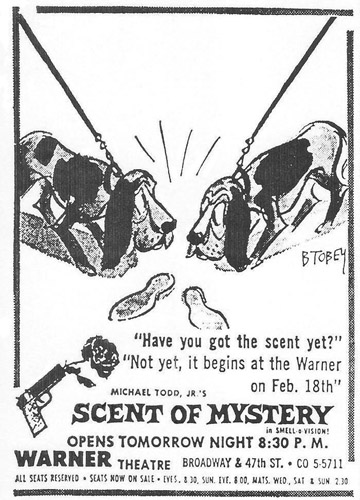 After its stint as the premiere Cinerama 3-strip venue in the 1950s, the
New York City WARNER was converted to ‘flat’ 70mm in 1959. Several
‘roadshow’ attractions were then featured, such as “Porgy and Bess” and
“Exodus”. Prior to “SCENT” opening on February 18, 1960, there was a
short revival run of “80 DAYS” to warm up Todd enthusiasm. In 1963 the
theatre was converted to 70mm Cinerama for “MAD WORLD” and was
eventually re-named the CINERAMA. After its stint as the premiere Cinerama 3-strip venue in the 1950s, the
New York City WARNER was converted to ‘flat’ 70mm in 1959. Several
‘roadshow’ attractions were then featured, such as “Porgy and Bess” and
“Exodus”. Prior to “SCENT” opening on February 18, 1960, there was a
short revival run of “80 DAYS” to warm up Todd enthusiasm. In 1963 the
theatre was converted to 70mm Cinerama for “MAD WORLD” and was
eventually re-named the CINERAMA.The premiere season of “HOLIDAY IN SPAIN” in Cinemiracle was set for December 22, 1961 at the Toronto EGLINTON. What did not bode well for this new partnership between Mike Jnr and National Theatres was the fact that two days before that opening, Weekly Variety reported that a deal had finally been inked for Cinerama, Inc. to take over Cinemiracle and its assets from National Theatres. This included all rights to the process, the film “WINDJAMMER” its negative and 45 prints, 23 complete sets of projectors, four cameras, all trade marks, etc. Following the (very successful) Toronto season there was a three week Cinemiracle run of “HOLIDAY IN SPAIN” at the Seattle PARAMOUNT, but this was probably the end of National Theatres interest in the film and the Cinemiracle format. IT is not clear whether the Cinerama/Cinemiracle takeover deal included any reference to poor old “HOLIDAY IN SPAIN”, but Mike Jnr was no doubt happy for Cinerama, or anyone, to screen the film. (And Cinerama, Inc. in turn was more than happy to have some new 3-strip material to screen at several of their venues - which were tired of reviving the travel titles, and eagerly awaiting the delayed arrival of the MGM bonanza). Mike Todd, Jnr would later sue the Cinemiracle people for $10 million, alleging breach of contract. Sadly, as with his other show business ventures, it seems unlikely he had any luck with that project either. |
|
 The smellies turned out to be a tough sell, and the Todd fortunes were
not helped by having a rival firm jump in with a ‘spoiler’, opening a
simpler competing system called ‘Aromarama’ at the New York City DeMILLE
theatre in December, 1959 - just a few weeks before “SCENT OF MYSTERY”
opened across the road at the WARNER. The smellies turned out to be a tough sell, and the Todd fortunes were
not helped by having a rival firm jump in with a ‘spoiler’, opening a
simpler competing system called ‘Aromarama’ at the New York City DeMILLE
theatre in December, 1959 - just a few weeks before “SCENT OF MYSTERY”
opened across the road at the WARNER. |
|
 Minnesota appears to have been the fourth state to launch “SCENT OF
MYSTERY”. It opened at the Minneapolis St Louis PARK on June 6, 1960
(after the 3 original ‘smellie’seasons had finished their runs). It was
shown WITHOUT the smell system, and with only 6 tracks of sound instead
of 8. This venue was converted to 70mm Cinerama a few years later. Its
only presentation in that format was “Battle of the Bulge”. Minnesota appears to have been the fourth state to launch “SCENT OF
MYSTERY”. It opened at the Minneapolis St Louis PARK on June 6, 1960
(after the 3 original ‘smellie’seasons had finished their runs). It was
shown WITHOUT the smell system, and with only 6 tracks of sound instead
of 8. This venue was converted to 70mm Cinerama a few years later. Its
only presentation in that format was “Battle of the Bulge”.It would appear that neither “SCENT OF MYSTERY” nor the 3-panel version of “HOLIDAY IN SPAIN” carried any screen credits other than an ‘Intermission’ title. Cinerama, Inc. later used the cut 65mm “HOLIDAY IN SPAIN” negative to produce several 70mm prints which were used in the mid-late 60s for 70mm Cinerama and ‘flat’ 70mm showings. These prints were slightly altered by the addition of two opening credits which can be seen on the Bluray: ‘Cinerama presents’ and “Holiday in Spain”. There were at least 3 “SCENT OF MYSTERY” 70mm prints, at least 5 Cinemiracle 3-strip prints of “HOLIDAY IN SPAIN”, at least 2 English language and at least 2 Spanish language 70 mm prints of “HOLIDAY IN SPAIN”. There have been at least 2000 Blurays of “HOLIDAY IN SPAIN” produced – get your very own copy from screenarchives.com |
|
 The main ‘mystery’ here seems to be: Was there ever a 5th state to show
“SCENT OF MYSTERY” in its original cut? I believe that the Boston CAPRI
was the intended venue – but it seems the season there didn’t eventuate. The main ‘mystery’ here seems to be: Was there ever a 5th state to show
“SCENT OF MYSTERY” in its original cut? I believe that the Boston CAPRI
was the intended venue – but it seems the season there didn’t eventuate. |
|
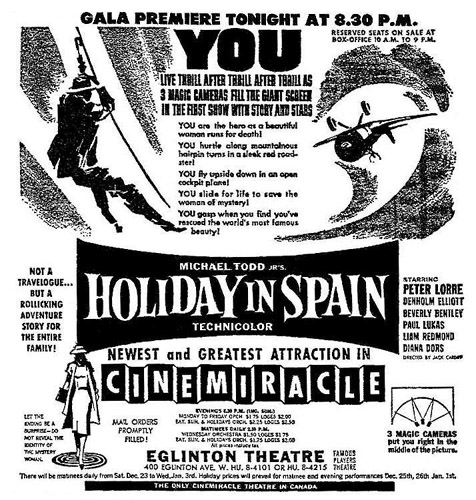 Optically processed to 3-panel Cinemiracle, the newly cut and named
“HOLIDAY IN SPAIN” followed “WINDJAMMER” at the Toronto EGLINTON in
Ontario, Canada, opening December 22, 1961. Somehow the ballyhoo seemed
to work, and its 19 week engagement here was the longest run the film
had in any form. After this season the cinema converted to 3-panel
Cinerama. Optically processed to 3-panel Cinemiracle, the newly cut and named
“HOLIDAY IN SPAIN” followed “WINDJAMMER” at the Toronto EGLINTON in
Ontario, Canada, opening December 22, 1961. Somehow the ballyhoo seemed
to work, and its 19 week engagement here was the longest run the film
had in any form. After this season the cinema converted to 3-panel
Cinerama. |
|
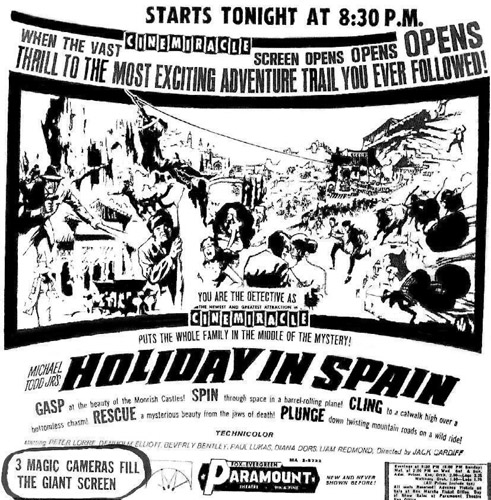 After its long Toronto season, the Cinemiracle version had a barely 3
week run in Seattle, Washington at the PARAMOUNT - which had previously
shown some of the Cinerama travel titles, and had later run “WINDJAMMER”
in Cinemiracle. This appears to be the only US Cinemiracle presentation
of “HOLIDAY IN SPAIN”. When it opened here on May 11, 1962, the film was
already showing as a Cinerama attraction at the BOSTON. After its long Toronto season, the Cinemiracle version had a barely 3
week run in Seattle, Washington at the PARAMOUNT - which had previously
shown some of the Cinerama travel titles, and had later run “WINDJAMMER”
in Cinemiracle. This appears to be the only US Cinemiracle presentation
of “HOLIDAY IN SPAIN”. When it opened here on May 11, 1962, the film was
already showing as a Cinerama attraction at the BOSTON. |
|
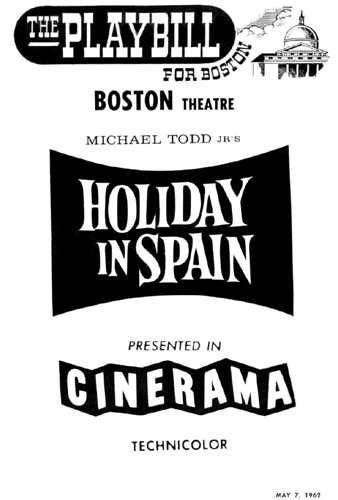 The
first Cinerama venue to screen the Cinemiracle print of “HOLIDAY IN SPAIN”
was the BOSTON Theatre - not surprisingly located in Boston, Massachusetts -
opening May 7, 1962. No mention was made in this, or any subsequent
advertising, of the photographic system, or the print process involved.
Staunch Cinerama venues such as the BOSTON, San Francisco ORPHEUM, Detroit
MUSIC HALL and Montreal IMPERIAL were desperately short of 3-strip product
by early 1962, and were glad of the use of a ‘filler’ for 3 months - to tide
them over until the new MGM titles became available. The
first Cinerama venue to screen the Cinemiracle print of “HOLIDAY IN SPAIN”
was the BOSTON Theatre - not surprisingly located in Boston, Massachusetts -
opening May 7, 1962. No mention was made in this, or any subsequent
advertising, of the photographic system, or the print process involved.
Staunch Cinerama venues such as the BOSTON, San Francisco ORPHEUM, Detroit
MUSIC HALL and Montreal IMPERIAL were desperately short of 3-strip product
by early 1962, and were glad of the use of a ‘filler’ for 3 months - to tide
them over until the new MGM titles became available. |
|
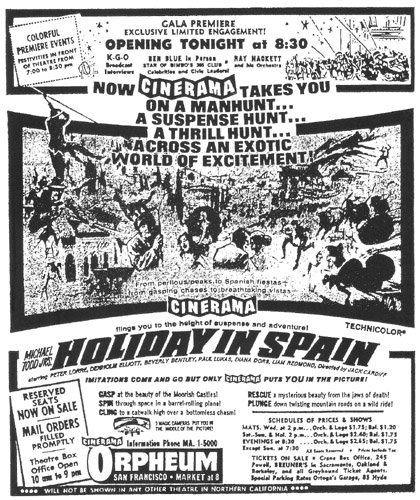 The San Francisco ORPHEUM ran “HOLIDAY IN SPAIN” for 10 weeks from May
29, 1962. Apart from minor alterations, like the insertion of the
‘Cinerama’ logo, the advertising used basically the same material
devised for the Cinemiracle release, even to the extent of claiming -
somewhat dubiously - that ‘3 magic cameras’ were involved. The San Francisco ORPHEUM ran “HOLIDAY IN SPAIN” for 10 weeks from May
29, 1962. Apart from minor alterations, like the insertion of the
‘Cinerama’ logo, the advertising used basically the same material
devised for the Cinemiracle release, even to the extent of claiming -
somewhat dubiously - that ‘3 magic cameras’ were involved. |
|
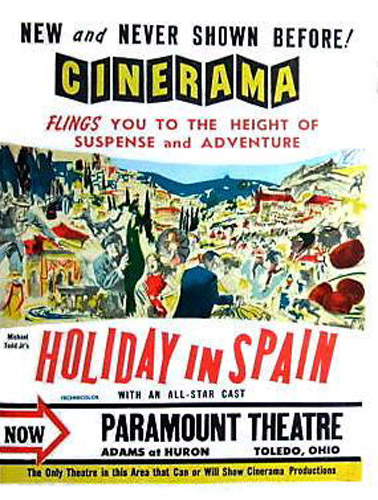 The Toledo PARAMOUNT opening of “HOLIDAY IN SPAIN” on July 20, 1962
meant that now FIVE Cinerama venues were presenting 3-strip prints of
this title simultaneously. Mid-1962 was the golden era for this movie –
enjoying, at that time, the closest it ever got to a ‘splash release’. The Toledo PARAMOUNT opening of “HOLIDAY IN SPAIN” on July 20, 1962
meant that now FIVE Cinerama venues were presenting 3-strip prints of
this title simultaneously. Mid-1962 was the golden era for this movie –
enjoying, at that time, the closest it ever got to a ‘splash release’.
|
|
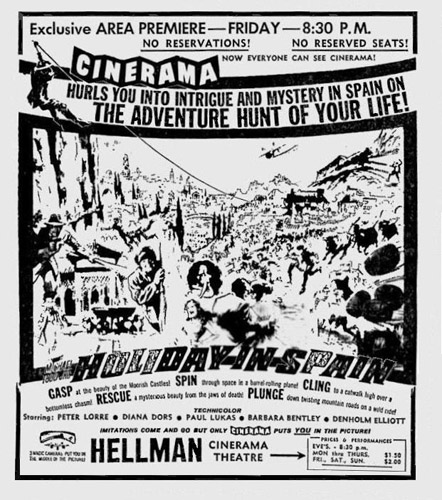 The Albany HELLMAN, in upper New York State, holds the record for the
shortest 3-strip run with this title. “HOLIDAY IN SPAIN” opened December
21, 1962 and could barely manage 16 days. (Not so bad when you know the
record Cinerama run at this venue was just 11 weeks with “HTWWW” a few
months later). The Albany HELLMAN, in upper New York State, holds the record for the
shortest 3-strip run with this title. “HOLIDAY IN SPAIN” opened December
21, 1962 and could barely manage 16 days. (Not so bad when you know the
record Cinerama run at this venue was just 11 weeks with “HTWWW” a few
months later). |
|
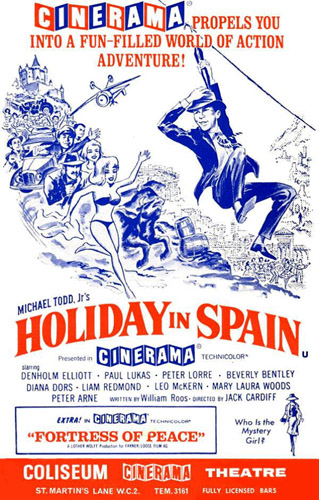 In the mid-1960s London could boast of having three Cinerama venues. In
its first overseas outing, “HOLIDAY IN SPAIN” opened at the COLISEUM
there on February 27, 1966 where ran for five weeks in 70mm Cinerama.
Many of the cast and crew on the film were British - so this was their
only opportunity to ever see the film (other than during a simultaneous
three week run at the Manchester ROYAL). In the mid-1960s London could boast of having three Cinerama venues. In
its first overseas outing, “HOLIDAY IN SPAIN” opened at the COLISEUM
there on February 27, 1966 where ran for five weeks in 70mm Cinerama.
Many of the cast and crew on the film were British - so this was their
only opportunity to ever see the film (other than during a simultaneous
three week run at the Manchester ROYAL). |
|
 In a mind boggling programming manoeuvre; after a May 1966 TWO week run
at the BYBLOS Cinerama theatre in Beirut, Lebanon, “HOLIDAY IN SPAIN”
was brought back in August for FOUR further weeks there! With the James
Bond secret service agent era by then well under way, it is interesting
to note the ‘007’ references in the advertisement. In a mind boggling programming manoeuvre; after a May 1966 TWO week run
at the BYBLOS Cinerama theatre in Beirut, Lebanon, “HOLIDAY IN SPAIN”
was brought back in August for FOUR further weeks there! With the James
Bond secret service agent era by then well under way, it is interesting
to note the ‘007’ references in the advertisement. |
|
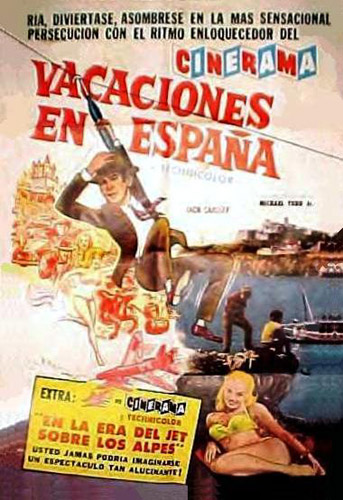 As it was entirely filmed there, “HOLIDAY IN SPAIN” held some hope of
appealing to the locals - so it was shown in Spain and Spanish speaking
territories in the late 1960s. Those familiar with the locales were
somewhat bemused by the way actual geography was ignored in advancing
the storyline. A character, seemingly seen in a familiar city, is
suddenly shown to be in another town altogether, for no apparent reason. As it was entirely filmed there, “HOLIDAY IN SPAIN” held some hope of
appealing to the locals - so it was shown in Spain and Spanish speaking
territories in the late 1960s. Those familiar with the locales were
somewhat bemused by the way actual geography was ignored in advancing
the storyline. A character, seemingly seen in a familiar city, is
suddenly shown to be in another town altogether, for no apparent reason. |
|
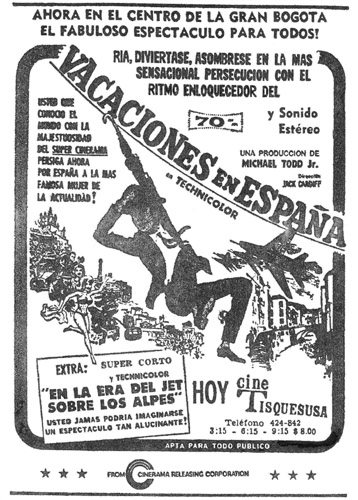 By 1968 Cinerama had set up their own film distribution company
(Cinerama Releasing Corp) dealing mainly in conventional format releases
of other people’s productions. After a six week Colombian season at the
Bogota SCALA in 70mm Cinerama, “HOLIDAY IN SPAIN” was revived four weeks
later at the Bogota CINE TISQUESUSA in ‘flat’ 70mm. The advertisements
used were the same, except that the Cinerama trade mark concertinas were
removed and replaced by a ‘70mm’ logo. By 1968 Cinerama had set up their own film distribution company
(Cinerama Releasing Corp) dealing mainly in conventional format releases
of other people’s productions. After a six week Colombian season at the
Bogota SCALA in 70mm Cinerama, “HOLIDAY IN SPAIN” was revived four weeks
later at the Bogota CINE TISQUESUSA in ‘flat’ 70mm. The advertisements
used were the same, except that the Cinerama trade mark concertinas were
removed and replaced by a ‘70mm’ logo. |
|
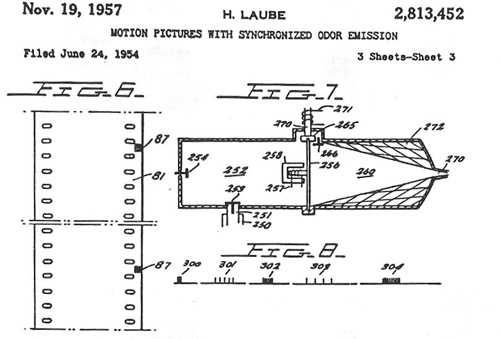 An image from Hans Laube’s patent application for his ‘Scentovision’
process, first lodged in 1954. The number ‘87’ shows where the
electronic pulse might be placed on the film to trigger the odour
release. Just exactly where the signal would eventually appear on the
70mm release prints of “SCENT”, I have not been able to determine.
Stanley-Warner (of Cinerama fame) would help financially with
development. A 10 minute demonstration film (with 17 smells) was
privately demonstrated in the Balcony of their NYC WARNER in September,
1956. An image from Hans Laube’s patent application for his ‘Scentovision’
process, first lodged in 1954. The number ‘87’ shows where the
electronic pulse might be placed on the film to trigger the odour
release. Just exactly where the signal would eventually appear on the
70mm release prints of “SCENT”, I have not been able to determine.
Stanley-Warner (of Cinerama fame) would help financially with
development. A 10 minute demonstration film (with 17 smells) was
privately demonstrated in the Balcony of their NYC WARNER in September,
1956. |
|
 A ‘scratch & sniff’ card gimmick was introduced for the theatrical run
of John Water’s 1981 feature “Polyester” - where each patron was
supplied with a card to smell at appropriate moments. (It was advertised
as ‘Odorama’). A ‘scratch & sniff’ card gimmick was introduced for the theatrical run
of John Water’s 1981 feature “Polyester” - where each patron was
supplied with a card to smell at appropriate moments. (It was advertised
as ‘Odorama’). |
|
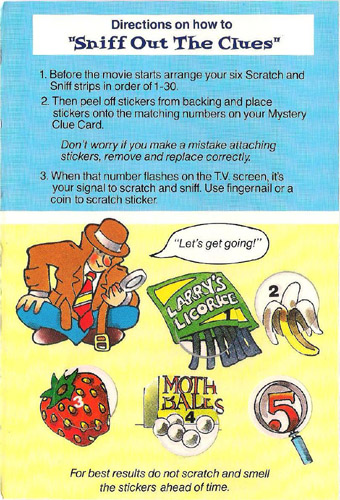 For many decades SCENT/HOLIDAY all but disappeared, except for a poor
quality 70 minute version shown on television 30 years ago - shortly
after “Polyester’ was released - featuring the same ‘scratch & sniff’
technique, with cards sold prior to the showing at convenience stores. For many decades SCENT/HOLIDAY all but disappeared, except for a poor
quality 70 minute version shown on television 30 years ago - shortly
after “Polyester’ was released - featuring the same ‘scratch & sniff’
technique, with cards sold prior to the showing at convenience stores. |
|
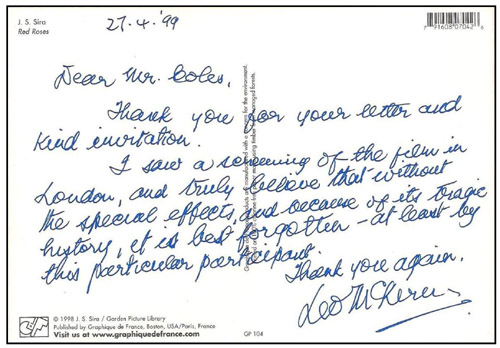 Leo McKern (1920-2002), who plays an American in “SCENT OF MYSTERY”, was
born and raised in Sydney - where he lost an eye in an engineering
factory accident. He drifted into acting and moved to the UK after WWII,
where he would be based for the rest of his life. (TV’s “Rumpole of the
Bailey” is probably his best remembered role). He returned to Australia
occasionally for film and stage work. His last Sydney stage appearance
was a 1999 season at the Opera House in “She Stoops To Conquer”. Leo McKern (1920-2002), who plays an American in “SCENT OF MYSTERY”, was
born and raised in Sydney - where he lost an eye in an engineering
factory accident. He drifted into acting and moved to the UK after WWII,
where he would be based for the rest of his life. (TV’s “Rumpole of the
Bailey” is probably his best remembered role). He returned to Australia
occasionally for film and stage work. His last Sydney stage appearance
was a 1999 season at the Opera House in “She Stoops To Conquer”.
|
|
 While
he was here, I wrote inviting him to a screening of John H. Mitchell’s
3-strip print of “HOLIDAY IN SPAIN”. It turns out he has managed to see it
at the London COLISEUM in 1966. He very kindly responded on a postcard with
a VERY thoughtfully chosen image (shown here). While
he was here, I wrote inviting him to a screening of John H. Mitchell’s
3-strip print of “HOLIDAY IN SPAIN”. It turns out he has managed to see it
at the London COLISEUM in 1966. He very kindly responded on a postcard with
a VERY thoughtfully chosen image (shown here). |
|
| Go: back - top - back issues - news index Updated 22-01-25 |
